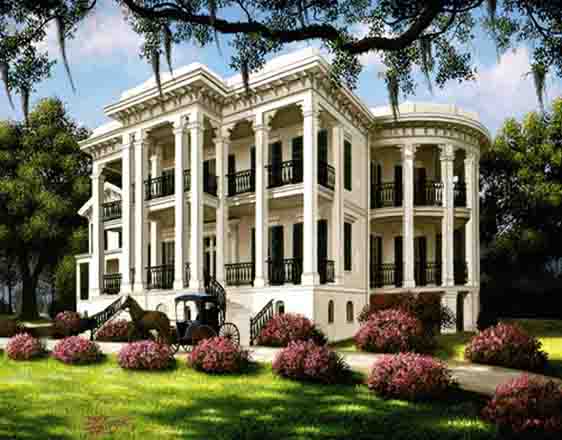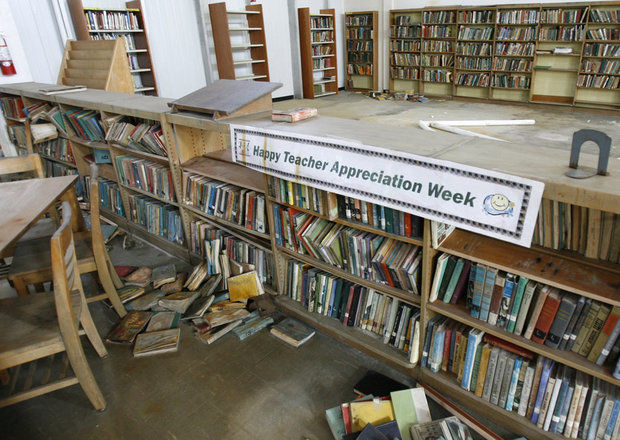New Orleans: Peeling back the Mask
Photos (Web Source, then merged and wrapped using Photoshop)
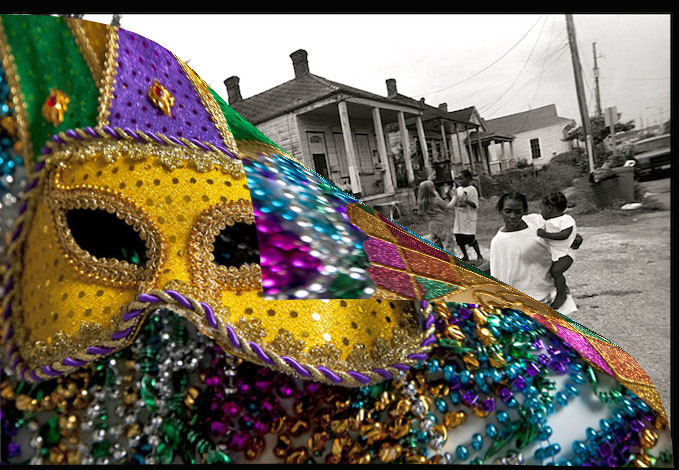
This post is actually a Tale of Two Cities. While New Orleans is widely known as the Big Easy to tourists and the well-heeled who call the city home, for a large and ever-growing number who work and live in the city, life is anything but easy. When the tourism mask is peeled back New Orleans becomes a city in which nearly half the population lives in poverty. Remember, this is a city that sits proudly among the Top 10 tourist destinations in the United States attracting over ten million visitors each year (Link)
January 1, 2018 (5300)
One a recent trip something that struck me is how New Orleans and Victoria, (our home city) are similar on several counts. Greater Victoria, the Garden City of Canada, has a population of roughly 365 thousand with New Orleans only slightly larger at 378. Both cities are sought after tourist destinations and while New Orleans is considerably hotter, both have agreeable climates, scenic waterways, and ample natural resources. Tourists in both cities are provided with first-class hotels, restaurants and tourist attractions, and even though Hurricane Katrina devastated New Orleans in 2005, the tourist trade now exceeds pre-Katrina levels. At this point, all semblance of the similarity ends. Continued in Part 2.
August 27, 2005, New Orleans was engulfed by Hurricane Katrina, a storm that carried a surge that breached the old and inadequate levees and flooded much of the city. It was one of the most destructive natural disasters in New Orleans history, yet much of the death and destruction was not caused by the storm but by wilful neglect — the failure to secure the city from the storm surge. That was a ‘black and white’ issue. To what extent has the city recovered?
1. The Mask: What the tourists see.
For visitors, the city presents a year-round fantasyland of boisterous, round-the-clock carousing that caters to every taste and where musicians, singers, and various other entertainers compete with the best. For anyone who loves music, particularly jazz, 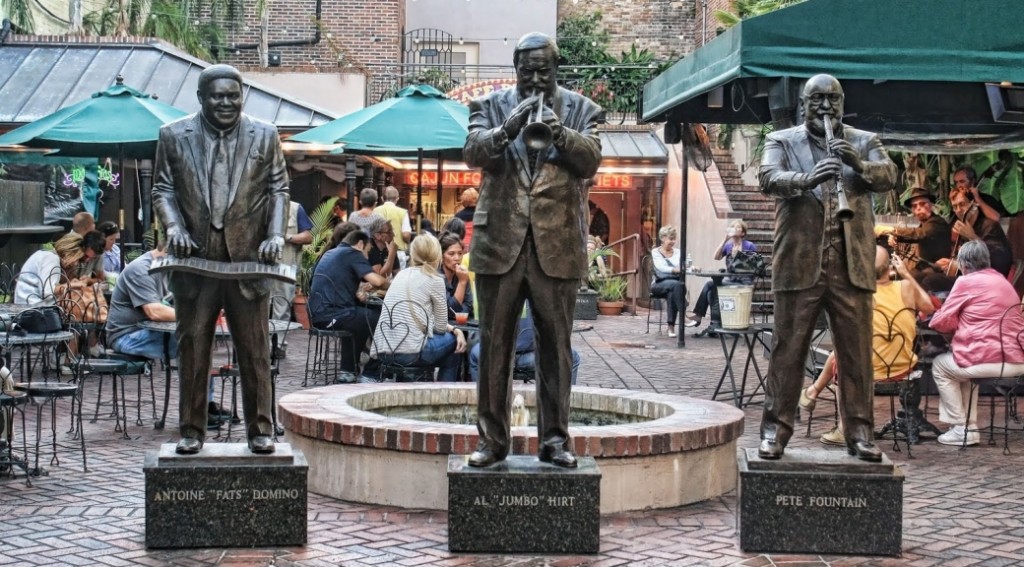 you will love New Orleans. Just spend an hour sitting in the open-air Café Beignet (Three Statutes in the Musical Legends Park) on Bourbon Street and you will be treated to the sweet sounds of jazz as ever-changing groups of local artists pick up the beat.
you will love New Orleans. Just spend an hour sitting in the open-air Café Beignet (Three Statutes in the Musical Legends Park) on Bourbon Street and you will be treated to the sweet sounds of jazz as ever-changing groups of local artists pick up the beat.
Wander along the Quarter to the north end where, on Frenchmen Street, you will likely find an ad hoc group of young men playing in a random brass group that will blow your socks off. Then, one day, walk along Basin Street to get a feel for the history of that fabled city.
For the more adventuresome, including the Catholics in our midst, Mardi Gras, “beginning on or after the Christian feasts of the Epiphany (Three King’s Day) and culminating on the day before Ash Wednesday,” is a celebration you should not miss. (Link) The celebration, also referred to as “Fat Tuesday, reflects the practice of the last night of eating richer, fatty foods before the ritual fasting of the Lenten season.” Whether anyone other than the poor has ever fasted in New Orleans is questionable, and whether this is a destination of choice for the Lenten season, is doubtful. If, by this point, you have not been able to strike the city off your ‘bucket list’ it will likely remain at or near the top until you finally decide to wade in. For most Canadians, it is less than a five-hour flight from any of our major centres.
Our first adventure to New Orleans came in 2013 when a group of family and friends celebrated the fortieth birthday of our oldest daughter Kari. As New Orleans was our departure point for a Caribbean Cruise, we spent four days in the city and were not disappointed. Obviously, the tens of thousands of others who joined us in the streets, bars, and restaurants in the famous French Quarter just after Mardi Gras, felt the same way.
For Canadians, New Orleans is an experience not unlike that of Las Vegas only on a much smaller and more personal basis. While New Orleans boasts one of the largest gambling casinos in the US, for the most part, the casino is not the reason people travel to New Orleans, they seek instead to taste the Jazz, Cajun food or search out Voodoo Spirits that wander the night and inhabit swamps filled with alligators, wild pigs and other exotic creatures. 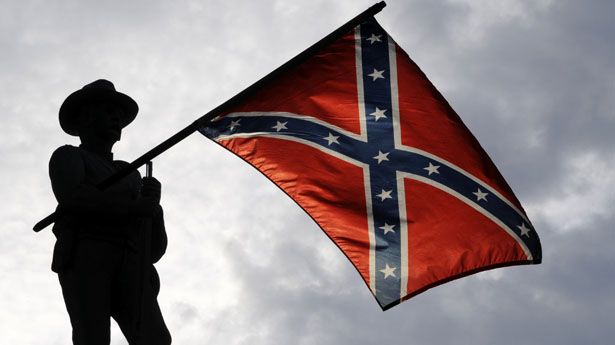 It is only when you travel along the Old River Road that you are reminded this State and City was dominated by large plantations whose owners forced black slaves to help them build fortunes greater than any of the gentry could possibly spend in a hundred lifetimes.
It is only when you travel along the Old River Road that you are reminded this State and City was dominated by large plantations whose owners forced black slaves to help them build fortunes greater than any of the gentry could possibly spend in a hundred lifetimes.
Photo (Web Source): The Confederate flag may have been removed from most state and City facilities in the south, but it remains close to the heart of many who live in Louisiana and several other Southern States.
The old Mississippi River Commemorative Tours best epitomize how the past continues to define (and haunt) the present in New Orleans as that past clearly delineates itself along racial and economic lines. Following is the web introduction to that “glorious” period when the Confederate Flag flew proudly over Louisiana Legislature, the New Orleans City Hall and most plantations:
South Louisiana is known for its beautiful antebellum architecture and there are plenty of plantation homes that are within an hour’s drive from New Orleans. Get a feel for the Antebellum South as you look out over rows of oak trees to the Mississippi River from the porch of a plantation home. The architecture and beauty of these homes alone are impressive – the stories that go with them are even better. Hear stories about the homes – the famous local families that built and owned them, the people that walked through their halls – the walls can’t talk, but your tour guide will. Book your tour now and discover a history so rich, you’ll feel like you’ve walked out of life and into a novel. (Link)
Painting: “The Nottoway mansion was completed in 1859 for Mr. and Mrs. John Hampden Randolph and their eleven children. The Greek revival and Italianate mansion boast 53,000 square feet, making it the largest plantation home in the south. Randolph acquired over 7,000 acres of land making his fortune in sugarcane.” (Web Source).
It’s easy to forget that massive homes such as this and the wealth each represents, were built on the backs of slaves whose lives were worth less than the sweat of their brow. In many ways, New Orleans today is not that far removed from those earlier times.
In Part 3 of the post, I write of personal experience about how close to the surface those connections to the old south run through the blood and economic lines of New Orleans and the deep south.
Before leaving this section, consider this: In all of Louisiana there is only one Antebellum Tourist Site that exclusively commemorates the lives of the hundreds of thousands of slaves who lived and died serving the owners of the plantations to which they were sold. The following quote is taken from that plantations web site:
The Whitney Plantation is located on the west bank of the Mississippi River, on the historic River Road in St. John the Baptist Parish, less than an hour west of New Orleans. Today, Whitney Plantation is the only plantation museum in Louisiana exclusively dedicated to understanding the facts of slavery. As a Site of Memory, with the focus on the lives of the slaves and their legacies, visitors can experience the world of an eighteenth- and nineteenth-century indigo and sugar plantation through the eyes of the enslaved people who lived and worked here. (Link)
Also, check Note 5 in the footer for further comment.
Note added September 8, 2015. There is an excellent narrated pencil-drawn video tells that traces the story of early settlements in North Central America. (LINK HERE)
2. Behind the Mask: What the tourists don’t see.
It was not until a second trip during August 2015, a seven-day visit with our grandson Grayson and his dad Ed who was taking in a Culinary Convention, that I had time to dig deeper. As part of the culinary group, we were afforded an opportunity to move behind the scenes and it did not take long to discover a city that was filled with what could easily be described as modern-day slavery. Poverty in New Orleans is always close by and that poverty is the worst in the United States and likely worse than could be found in any modern democracy in any part of the world. A few articles even compare the poverty experienced in New Orleans to that in some third world countries.
While poverty affects blacks far more than whites, conversations and observations suggest poverty is, to some extent, and equal opportunity blight that scars the very soul of New Orleans. It’s reported that almost everyone calling New Orleans home is ‘gainfully’ employed, that statement is challenged further in this post. What soon becomes clear, is that extremely low wages, lack of enforceable labour laws, sub-standard and expensive housing, poor health care, abysmal schooling and a long list of other ills, leaves half the population with little hope for the future.
Comparisons to Victoria, British Columbia
(This para was quoted in the opening of this post – skip to the next paragraph to continue) Another thing that struck me is how, in some ways, New Orleans and Victoria, British Columbia (our home city) are similar on several counts. Greater Victoria, the Garden City of Canada, has a population of roughly 365 thousand with New Orleans only slightly larger at 378 thousand. Both cities are sought after tourist destinations and while New Orleans is considerably hotter, both have agreeable climates, scenic waterways, and ample natural resources. Tourists in both cities are provided with first-class hotels, restaurants and tourist attractions, and even though Hurricane Katrina devastated New Orleans in 2005, the tourist trade now exceeds pre-Katrina levels. At this point, all semblance of the similarity ends. Check the following numbers.
New Orleans attracts over 10 million visitors each year or 15 to 20 twenty times that of Victoria and those visitors spend nearly eight billion dollars whereas Victoria might take in $750 million in a good year. In New Orleans, the eight billion is an 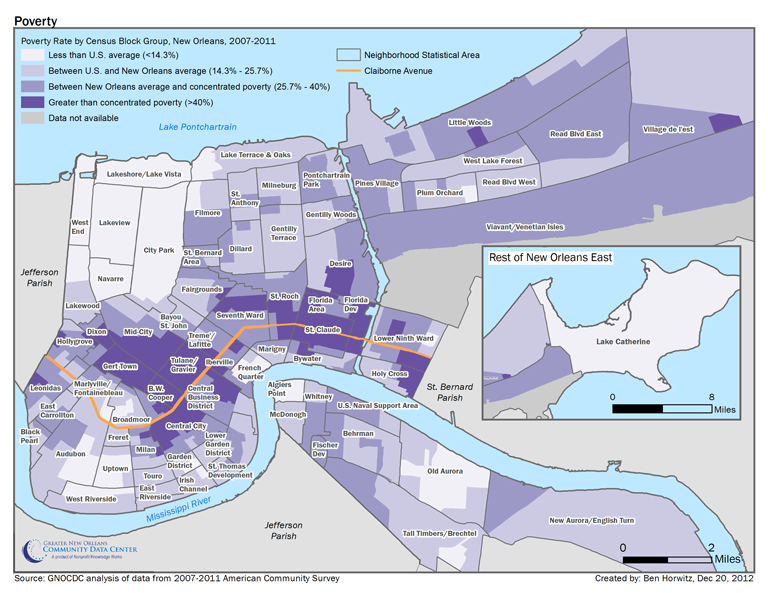 amount greater than that generated by the combined income of the next three economic drivers – oil, gas, and shipping. Even with all the advantages that massive income provides, New Orleans is a city serviced by the blood, sweat, and tears of those living in poverty (Link)
amount greater than that generated by the combined income of the next three economic drivers – oil, gas, and shipping. Even with all the advantages that massive income provides, New Orleans is a city serviced by the blood, sweat, and tears of those living in poverty (Link)
Chart (Web Source). Click to Open (The French Quarter is near the centre of the photo on the sharp bend in the Mississippi River.)
Walk for ten or fifteen blocks out of the French Quarter and, except for pockets of renewal and some major tourist attractions, you will see broken and boarded up businesses and homes, deteriorating streets and sidewalks and the face of a people who have come to realize the American Dream is not something that will soon be visited upon New Orleans. Then drive through the Lower Ninth Ward to cement your understanding. Finally, take the Natchez paddle wheeler along with the ‘ole’ Mississippi and while you enjoy the beer, Cajun Cuisine, and Jazz Quartet, scan the shoreline. On that two hour trip, you will see a waterfront that remains much as it was after Katrina struck in 2005 and many of the manufacturing district buildings look as if it were transported in from some war zone (Link)
For the vast majority working in the tourist trade, poverty is a fact of life. New Orleans has an adult and child poverty rate that hovers near 40%, the highest in the United States, a distinction shared with Atlanta, Georgia. Add in the low-income middle 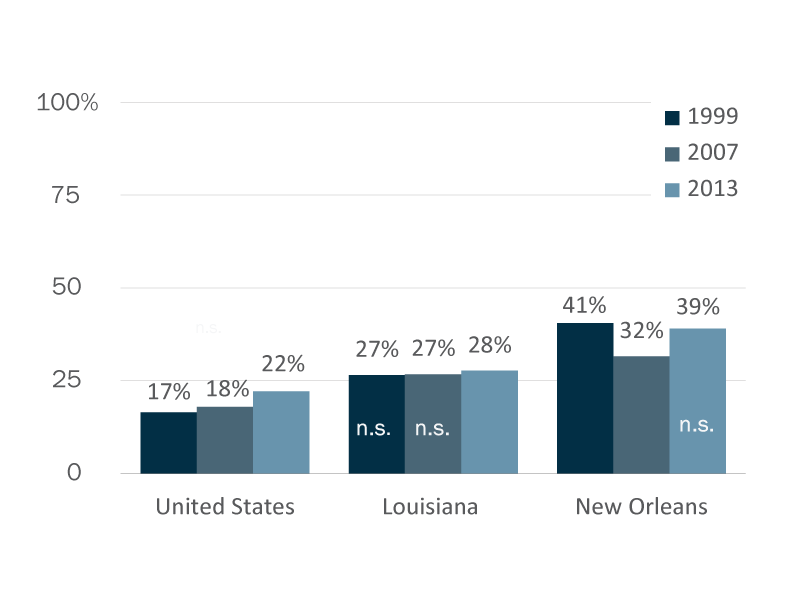 class and well over half of the people in New Orleans can only dream of making ends meet.
class and well over half of the people in New Orleans can only dream of making ends meet.
Chart (Web Source): Poverty levels in the United States, Louisiana and New Orleans (Click to open.)
While the poverty rate in BC and Victoria is above the national average and far higher than it should in a city as rich as the one in which we live, it is still less than half that of New Orleans and if you walk through any area of Greater Victoria you will never see anything remotely approaching the distressing signs of poverty that exists in the Big Easy. Perhaps, some aboriginal communities display a few signs, but even in those communities, you do not see the abject poverty endured by nearly half the population in New Orleans.
There is a rather strange twist in all this, one that puts an end to those who argue poverty exists because people are too lazy to work, preferring instead to remain on the dole, drink to excess, do drugs or watch TV all day. You know who I mean, all those who insist upon drug testing in order to qualify for income assistance as is the case in several southern US states. Of course, some people living in poverty do those things, just as do some in every economic group, but the following facts make it hard to justify sticking with the hard-nosed position.
The unemployment rate in New Orleans is just over 5% (about the same as Victoria), a figure that is among the lowest in the United States. While there will obviously be those who have dropped out and are no longer counted as unemployed, you cannot reasonably conclude those living poverty are there because they are too lazy to work. Quite the opposite is true. The poverty that exists in New Orleans is primarily the result of an extremely large number of people working in the tourism and service industry where starvation wages (e.g. modern-day slave labour) are the norm. While the US Federal minimum wage of $7.25 applies, tipped workers in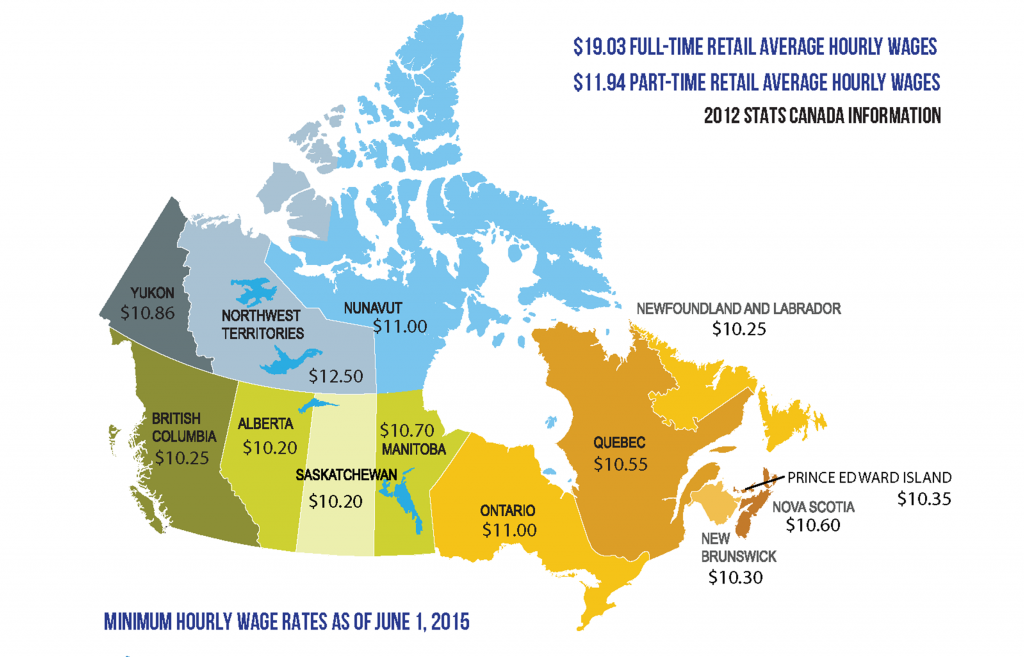 Louisiana need only be paid $2.13 per hour and you can bet a significant number of employers in the city take full advantage of the extremely low wages in order to pad their profit margin.
Louisiana need only be paid $2.13 per hour and you can bet a significant number of employers in the city take full advantage of the extremely low wages in order to pad their profit margin.
Minimum Wage Chart (Web Source). Canada is no glowing example and one is left to wonder, what if the minimum wage was a living wage? (Link) (Click to Open)
While all Canadian Provinces have a minimum wage of $10.00 or greater, there is no minimum wage law in Louisiana, a distinction shared with four other Southern States – Alabama, Mississippi, South Carolina, and Tennessee. While the city of New Orleans is working towards implementing a minimum of $10.00, that wage would only apply to businesses doing work for the city and who hold contracts of a $100,000 or more.
Given 80,000 people work in the leisure and hospitality sector (with 40,000 indirect low paying tourism jobs) the $10.00 rate would not apply. Even in the face of this great inequity, many business owners vigorously oppose a move to raise the minimum wage just as have many businesses in Canada (e.g. Alberta, the richest Province in our country) claiming a rise in the minimum wage will kill jobs. Well, consider this – poverty level wages kill men, women and children not higher wages.
As far as I can discern, there is simply no evidence to support the contention that raising the minimum wage to give families and children a lift out of poverty will be worse for New Orleans, or for our own country and the majority of our people, than is treating them as disposable segments of our economic system. On the other hand, there is ample evidence to show that the poverty which often accompanies low wages, leads to all kinds of social problems (Link)
Looking at the New Orleans low pay situation from another perspective is a study by Bloomberg (link). His conclusions sum it up nicely: “Using a measure of income distribution called the Gini coefficient, New Orleans is ranked as second-worst in the (US) for income inequality. Only Atlanta (GA) had a greater share of its total income concentrated in the hands of fewer people. In New Orleans, the poorest 40 percent controlled just 7.5I% of the income.” In other words, “If New Orleans were a city of 100 people having a combined income of 100 dollars, the poorest 40 would take away $7.51”, whereas the richest 20 would take $60.00 and the remaining 32, the “middle class”, would share $33.49. That this is happening in a small city with an eight billion dollar tourist windfall is simply unfathomable. (Link)
Remember also, this is a city whose cost of living is equal to or greater than that of Victoria, a city that is among the most expensive in Canada. For instance, a one-bedroom apartment in what we might consider an average building in an average residential neighborhood in Victoria, would, in New Orleans rent for a staggering $1700 – $2000 a month. A basic food basket and other services are proportionately priced.
3. Children and Poverty
With so many adults living below the poverty line, is it little wonder that 40% of the children in New Orleans are growing up in poverty. Without going into the gritty details, it is generally accepted that poverty breeds poverty in a cycle that continues from generation to generation and low-income earners of New Orleans, with or without Katrina, have been on that treadmill for  decades, indeed, it is likely a systemic condition that has existed since the end of the civil war, a war that brought to an end one kind of slavery. In the years following Katrina, the situation has grown worse, and while both whites and blacks are affected, it is the black community that carries the greatest burden. This is no better demonstrated than in education.
decades, indeed, it is likely a systemic condition that has existed since the end of the civil war, a war that brought to an end one kind of slavery. In the years following Katrina, the situation has grown worse, and while both whites and blacks are affected, it is the black community that carries the greatest burden. This is no better demonstrated than in education.
In the aftermath of Katrina, the Louisiana State Legislature seized the opportunity to pass a law that closed all public Schools and dismissed the community-based Boards of Education. The process was fully described in a book by Naomi Kline, The Shock Doctrine.
After the passing of the legislation, all teaching and support staff in public schools were laid off, then fired notwithstanding they were Union members and had rights under Louisiana labour legislation. In the months following all schools were reconstituted as Charter Schools and new staff hired, many at a minimum wage and most from outside Louisiana.
Because the new Charter Schools studiously avoided rehiring local teachers they went on a nationwide hiring campaign in which they gathered hundreds of mostly white graduates from Community Colleges and Universities across the United States. These graduates were offered signing bonuses and housing incentives if they choose to begin their careers in New Orleans. Even though the pay was low, there were few benefits and housing was at a premium, it was an exciting opportunity for many young people.
Photo (Web Source): Teacher Appreciation week was interrupted permanently by Katrina and the New Orleans State Legislature. The parish teachers who were fired won the final battle in the Supreme Court but lost the war and New Orleans lost a valuable part of the black middle class. (Link)
Locally, the entire process had the effect of decimating the population of homegrown teachers, many of whom had years of service, pension plans, health care, and assorted other benefits. If those teachers wanted work, they either had to leave New Orleans or join the ranks of the working poor when forced to take low paying jobs in the service industry. It was the largest Charter School experiment in US history, but how, you might ask, did those new privately operated schools perform? ((Link)
While the State of Louisiana commissioned several studies that showed better results, those results were largely an illusion. For Charter Schools, two things were done to help them rate higher than the public schools. First, over time the standards were slowly lowered to assist some in achieving a passing grade, and second, the far more devious scheme – if a Charter School continued to show poor results over two or three years, that school was allowed to close its Charter, then reopen for the following year using new name and new Charter number. That gave the school a clean slate with having done nothing to improve the school. In many cases, new teachers were hired. Each year many of the poorest performing Charter Schools in New Orleans follow this devious path. (Link)
Such is the manipulation by State and Local Governments hell-bent on achieving privatization of services where Unions had achieved advances or where Community Groups (e.g. School Boards) had power and where teachers and support staff were paid a livable wage and benefits.
Several Unions and Schools Boards, primarily those in the Black community, fought the arbitrary change in court and while they won several cases in the lower courts, the Louisiana Supreme court overturned virtually every case. Today these cases continue to wind their way to the US Supreme Court, however, as was the experience of the British Columbia Teachers Association (BCTF) when the government unilaterally changed their contract, the cases took so long in court (over 12 years) the end results that supported teachers at every level was virtually meaningless.
It appears this entire process of pushing both blacks and whites into an ever-increasing level of poverty is nothing new in the southern states. Fingers are pointed at blacks just as at aboriginals in Canada suggesting individuals fail because of personal shortcomings (laziness, alcohol, drugs, etc.), but that is because racism plays a huge role in sustaining the definition and this was no better demonstrated than on a bus tour we took to the Mississippi swampland.
3. Good Old Boys: A Racist Meltdown
Of course, one sour incident does not prove the rule, but when a leading contender in the Republican Party can make the most outrageous racial slurs and is supported by a sizeable percentage of the party, is it little wonder that race  relations in most areas of the south take a turn for the worse?
relations in most areas of the south take a turn for the worse?
Photo (Web Source, Credit below) Republican presidential candidate Donald Trump greets supporters after his rally at Ladd-Peebles Stadium on August 21, 2015, in Mobile, Alabama. The Trump campaign moved the next rally to a larger stadium to accommodate demand. You will be hard-pressed to pick out the few blacks or Hispanic faces in this ecstatic crowd. (Photo by Mark Wallheiser/Getty Images)
The above rally took place not long after we did a tour with a driver who was a white man in his mid-sixties who was taking us to the Honey Island Swamp system in his home state of Mississippi.
On the way out he provided some background of his life, which it appeared had taken a turn for the worse in 2005 and then again in 2008. He was now driving tour bus, probably at minimum wage, and his accent and manner of speaking suggested he was a young of the good old days before the southern states faced the challenges of desegregation. As our group was mainly white with the exception of one young woman from South America, he seemed comfortable in thinking he was among friends.
While he was not all that eager to provide any background on the devastated areas around Lake Pontchartrain, he slowly engaged as a result of questions asked by Grayson, my eight-year-old grandson, who was riding shotgun. However, a few hours later on our return trip with the same driver and group, things turned decidedly ugly.
While driving over that massive bridge that spans Lake Pontchartrain, the driver somehow flipped the conversation over to the Confederate Flag and what it represented to the people of the South. It was not long before he had a complete meltdown. He began with an invective laden rant about blacks and how they should be thankful for the Confederate flag.
He clearly stated his belief that their ancestors, on arriving in America from Africa, were happy to be living under that flag in a country that gave them a much better life than they had in Africa. He made no mention of the fact they were captured and sold by the hundreds as slaves to the plantation owners whose mansions and family fortunes are now so revered.
As he continued his hate speech, the depths of his condemnations stunned us. Even Grayson turned his back, said nothing and just looked out the window of the Van. In the back, we neither challenged nor engaged the driver choosing instead to redirect the conversation in a different manner among ourselves. Finally, the driver stopped talking and just drove, although he was obviously seething. During the worst parts of his conversation, it seemed possible he might be one of those people who would reach into the glove compartment, pull out a gun and start shooting.
Back at the hotel, I mentioned the incident, but no one seemed all that interested in engaging on the subject so I let it drop as I was not in a position to begin changing the culture of New Orleans, Louisiana, Mississippi or, indeed, any area of the Deep South. If they are hell-bent of moving towards another civil rights movement that’s pretty much their business. Besides, if would-be leaders of political parties can spew hate to attract voters, what is stopping an old man whose life has apparently taken a turn for the worse, from speaking his mind?
While I often challenge on issues that arise in Canada, I certainly think the relationships we have developed among our people and with our various levels of government has little in common with what is happening in many parts of the United States, although events in Canada over the past decade suggest we have taken a turn for the worse in regards to treatment of minorities, the working poor, those living at the margins of society and other groups who are not ‘Canadian’ enough. When I look at the United States, the reflection I see is becoming a little to clear.
In my opinion, taking a more compassionate stance does nothing to hurt our society and in fact, will enhance it. Because children are particularly vulnerable, we need to continue providing a first-class public education, health care and a life that is free from poverty as possible. We cannot afford to cast aside children and vulnerable adults in the name of austerity.
Part of the plan to help us move along this path will require all workers being given a living wage and working conditions that provide for benefits so everyone can share in the immense wealth that has been bestowed upon our country. If we fall into a recession it will not be caused by the fact our working poor are given a living wage, it will be caused by you and me not being satisfied with our share and wanting more.
4. How might things be changed?
In finding a fix for the challenges posed by poverty, the good news is that when unemployment is low and city income high, fixing the ‘working poor’ problem is much easier than if unemployment is high and there were no jobs because the city is broke as is the case in several American cities and towns (and some Canadian) struck by a massive downturn in manufacturing or traditional jobs (e.g. auto, steel, mining, forestry, fishing, etc).
In New Orleans and Canada, there is a need to redistribute a portion of our wealth from the top towards the bottom as a means to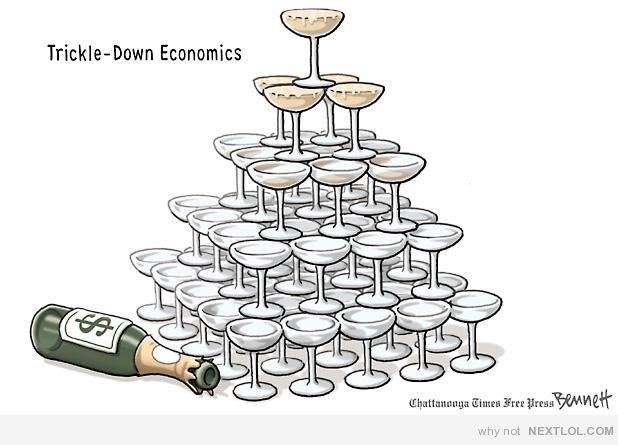 lift more people into the middle class. If a few of the very rich fall into the upper-middle class in the US and Canada, it would be a small price to pay for easing the burden of the working poor. We are not talking about welfare, but about providing a livable wage of around $22.00 per hour, a far cry the current standards, yet many people continue to profit from the pain of others.
lift more people into the middle class. If a few of the very rich fall into the upper-middle class in the US and Canada, it would be a small price to pay for easing the burden of the working poor. We are not talking about welfare, but about providing a livable wage of around $22.00 per hour, a far cry the current standards, yet many people continue to profit from the pain of others.
Cartoon (via Nephew Greg): While this is a tongue-in-cheek look at trickle-down, it does present the problem of big business and private individuals hoarding cash and other assets.
It became evident after Katrina that a sizeable number of people made windfall profits by buying up businesses and real estate at ten cents on the dollar. Many Canadians did that in the US after the 2008 financial meltdown. There is nothing wrong with this per se as someone needs to move in to help reconstitute the business community and economic drivers, but when done in a manner that removes much of the profit that would normally be re-invested into a community, then the recovery only serves to perpetuate poverty. On the other side of the coin when an extra $10.00 is given as an added incentive to a worker by doubling the minimum wage, that $10.00 does not go into an investment portfolio in the Grand Caymans, it goes immediately into the local economy. There is plenty of literature that explains the multiplier effect of dollars spent at the community level.
An example of businesses being revived in New Orleans after Katrina, one five-star restaurant in the French Quarter was one of three purchased by an outside investor. That investor grabbed the restaurants at fire-sale prices and after cleaning them up, putting then back in business and with the return of tourists, all three were doing a booming business. This was good news for a city that was on its knees. The bad news, many investors were absentee so most of the profit left the community and because all of them were paying poverty wages, nothing was recycled at the lower levels.
The same applied to the large hotel chains such as the Sheraton, Marriott, Hilton and, of course, Harrah’s Casino. If just a small percent of the profit from major chains was redirected to paying a living wage to their employee’s lower-tier employees, those dollars would be immediately used to help rebuild the community and everyone would be lifted up. I rather suspect a siphon up effect would work much quicker and have more immediate results than trickle down.
New Orleans could be transformed in just a few years if as little as five percent of that eight billion-dollar tourist legacy was spread back into the community through higher wages. Every penny of a minimum wage of $15.00 – $20.00 would be spent in the community. Will this happen? Probably not because the richest people in any country will fight tooth and nail to shield every penny they have from either the taxman or through any form of income redistribution. You have all heard the refrain many times.
Why is it so many people, particularly the relatively well off, take such a strong stand against paying a living wage? It’s surely not going to break them and would likely improve conditions for everyone (e.g. less crime, fewer health problems, more money into the economy, etc.). While doing so is certainly not going to cure all the challenges facing society, it will go a long way toward correcting at least some. Washington State and Alberta seem to be on the right track and while it may cause some short-term pain, in the long term everyone will gain.
Harold
April 16, 2016. Also link to a recent update: A Tale of Two Cities
Further notes and links:
1. This short TODAY news clip presents a glowing snippet of the recovery affected in New Orleans. While all the examples used in the clip are true, they represent only a small part of the picture and that part is the mask that covers the poverty and misery that is New Orleans. This news clip might better be called an infomercial made by the New Orleans Chamber of Commerce. Link: New Orleans Today by Al Roker
2. A good article on attitudes towards poverty posted on FB by my nephew Greg Yochim: Who is Really on Food Stamps
3. Check this video which includes a section about New Orleans. It is a video parable that speaks volumes about our society today: Inside Amy Shumer Scroll to the video about National Dog Day.
4. Another excellent article from Nephew Greg: A Canadian City That Once Eliminated Poverty and Everyone Forgot About It.
5. On commemorating the lives of those who lived and died as slaves in Louisiana, try this comparison. What if, years after World War II, the main remembrances of the brutal Nazi regime and the treatment of the Jewish people were the homes, factories, and farms of those who robbed, enslaved, abused, then killed the Jewish people. That is essentially what has happens in New Orleans, all of Louisiana and most of the south. A good proportion of black people today, although they are ‘free’, are treated little better than if they are still slaves and the fact no one even cares to show remembrance as to how badly they were treated in the antebellum south speaks volumes.
Addendum: November 9, 2016 (Update)
Victoria, B.C.
US Election: Donald Trump President
I woke early this morning to see what happened and cannot say I am the least bit surprised. The US is a deeply divided nation and much of that division seems to lie along the fault line of poverty. Over the past few decades, we have all watched the well-heeled establishment in the US protect themselves again and again and again against being held accountable for their misdeeds. 2008 was just the latest in a series of financial disasters precipitated by greed.
The short trip Ed Walker (my son-in-law), Grayson (grandson) and I took to New Orleans in August 2015 clearly revealed a fault line along the “black and white”, “rich vs poor” axis. The poverty, the desperation, the lack of hope in New Orleans was being repeated throughout the south and parts of almost every other State. It was hard for me to believe that two cities, Victoria and New Orleans, or even Louisiana and British Columbia, could be so similar in many ways, yet very different when it came to a poverty that, in much of the south, has extinguished any hope for a better future for a significant portion of the population.
I don’t know the demographics of how the US Vote count flowed out, but almost every state across the southern US voted for Trump, a man who is as establishment as you can get, and Clinton the very essence of all that is rich. For different reasons people of the mid-central US choose Trump over Clinton, and although she was well-qualified to lead the country, she simply never understood the anger that was enveloping the country along the fault line of poverty.
Perhaps Trump is the only person in a batch of rotting apples who may be able to shake the establishment to its core in a manner that allows the country to re-establish a society based upon the ideals on which it was founded – equality and equal opportunity. Trump may provide the impetus for change but it is more likely he will demonstrate once and for all that the rich and big business will look after their interests first, last and always. The country could very well descend into another civil war before the rich realized what was happening.
On a comparative note, my wife and I, along with two friends, Garth and Esther, recently returned from Viet Nam and Cambodia) where we were completely enamored of the people, a people that have lived through the worst the world has to offer, yet have come out the other end as a gentle and loving society where it does not appear large numbers of people are left behind. Comments about those two countries appear in recent series of travel posts – Resilience of the Human Spirit – posted in November 2016.
What might the future hold for the citizens of the United States? I don’t know, but hopefully, the coming four years become one of those momentous times that leads to positive change rather than complete destruction.
(6056)
Tags: Confederate Flag, Donald Trump, Ed Walker, French Quarter, Grayson Walker, Harold McNeill
Trackback from your site.

